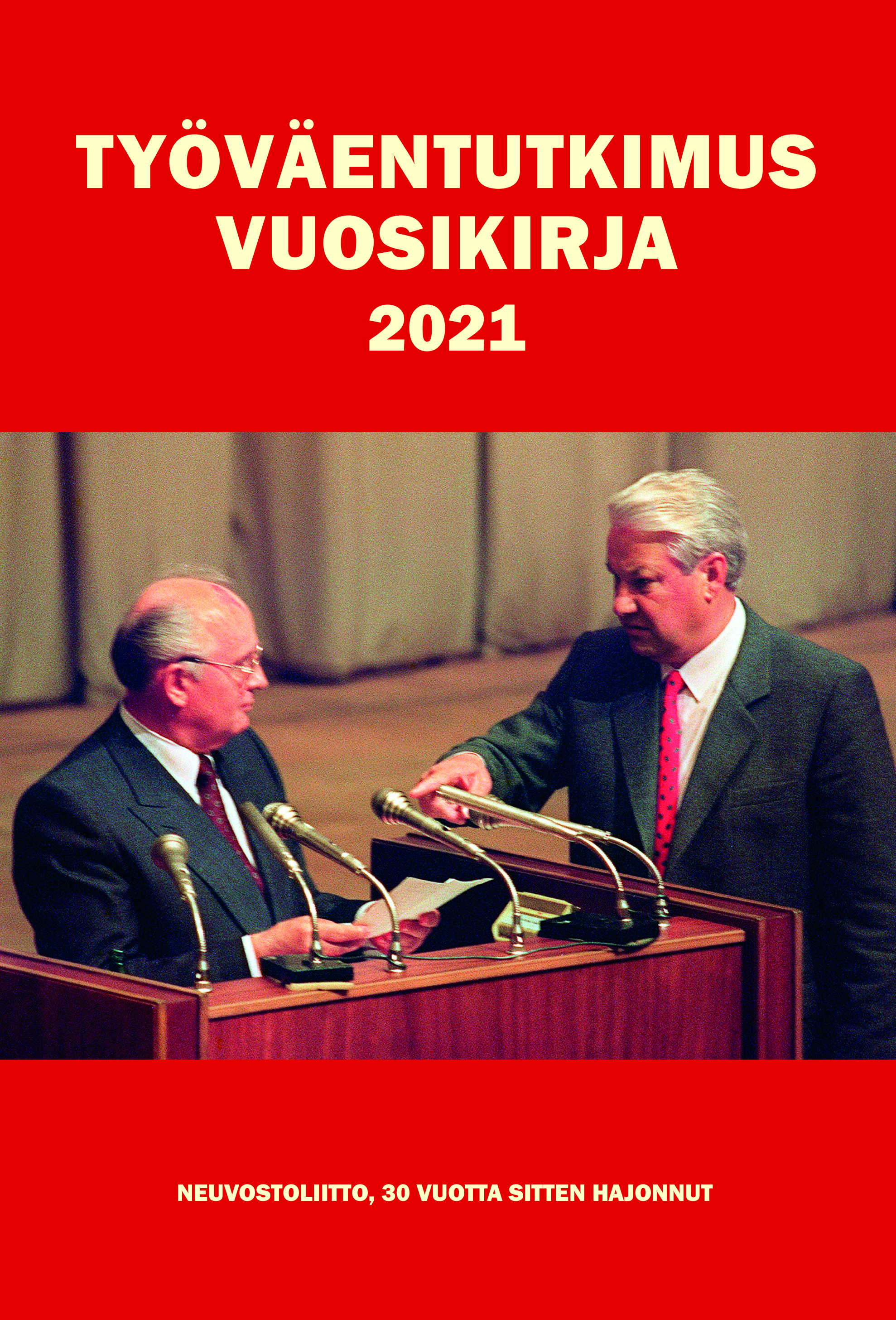The Rise and Fall of Soviet Sports
DOI:
https://doi.org/10.37456/tvt.112968Keywords:
sports, physical culture, Soviet UnionAbstract
Russia was one of the founding members of International Olympic Committee in 1894. Russians participated in Olympic Games in London (1908) and Stockholm (1912). The socialist revolution in 1917 changed the whole state, including its sport practices. After the bloody civil war (1918–1921) and the establishment of the Soviet Union (1922), the state strived to reorganize the whole body culture. In the Soviet body culture, the military body, working body and sporting body were idealized.
The popularity of competitive sports increased considerably in the 1920’s. In 1928, Russians organized a huge sport event, Moscow Spartakiad. It was a multi-sports event for workers and an alternative to the “bourgeois” Olympic Games held in Amsterdam in the same year. The athletes of the Soviet Union participated in Summer Olympics for the first time in Helsinki in 1952.
The Soviet Union was successful in Olympics. Between 1952 and 1988 the Soviet athletes accomplished 1 010 Olympic medals in Summer Olympics, and between 1956 and 1988 they accomplished 194 medals in Winter Olympics. After the collapse of the Soviet Union, athletes of Russia have competed under the flag of International Olympic Committee. The previous Soviet republics have participated in international sport events as independent states. The influence of the Soviet sport system has been significant not only for Russia but for many new countries as well. Sports were an important part of the education system and identity work in the Soviet Union. Many of the Soviet sport practices have persisted and continued to exist after the fall of the socialist state.
References
Applebaum, Anne. Gulag: A History of the Soviet Camps. London: Penguin Books, 2003.
Buntsuk, M. F. Neuvostoliiton liikuntaorganisaatio. Liikuntatieteellisen Seuran julkaisu 71. Helsinki: Liikuntatieteellinen Seura, 1979.
Eichberg, Henning. “Body Culture.” Teoksessa Routledge Companion to Sports History, toim. S. W Pope & John Nauright, 162–181. London: Routledge, 2010.
Figes, Orlando. Vallankumouksen Venäjä 1891–1991. Helsinki: Siltala, 2021.
Hentilä, Seppo. Suomen työläisurheilun historia. Vol. 1, Työväen Urheiluliitto 1919–1944. Hämeenlinna: Karisto, 1982.
Itkonen, Hannu. Liikkumisen sosiologia. Tampere: Vastapaino, 2021.
Itkonen, Hannu & Kalervo Ilmanen. ”Neuvostourheilusta Venäjän sekajärjestelmään.” Idäntutkimus 15, no. 4 (2008): 18–28.
Itkonen, Hannu & Pentti Stranius. Liikettä Venäjän Karjalassa: Tutkimus liikuntakulttuurin muutoksesta. Karjalan tutkimuslaitoksen julkaisuja 137. Joensuu: Joensuun yliopisto, 2002.
Keys, Barbara. Globalizing Sport: National Rivalry and International Community in the 1930s. London: Harvard University Press, 2006.
Keys, Barbara. “Soviet Sport and Transnational Mass Culture in the 1930s.” Journal of Contemporary History 38, no. 3 (2013): 413–434.
Kim, M. P. et al., toim., Neuvostoliiton historia: Sosialismin aikakausi. Moskova: Kustannusliike Edistys, 1978.
Kokkonen, Jouko. ”Oikeiden olympiakisojen maa.” Teoksessa Sadan vuoden olympiadi: Suomalaisen olympialiikkeen historia, toim. Vesa Tikander et al., 108–173. Porvoo: WSOY, 2007.
Lewin, Moshe. Neuvostoliiton vuosisata. Helsinki: Like Kustannus, 2006.
Makoveeva, Irina. ”Soviet Sport as Cultural Phenomenon: Body and/or Intellect?.” Studies in Slavic Cultures, no. 3 (2002): 9–32.
Mesham, Stuart, toim. EURO 2020: Suuri jalkapallokirja. Helsinki: Readme.fi, 2021.
Metsä-Tokila, Timo. ”Tiellä olympialaisiin: Huipulle tähtäävän urheilun ja koulutuksen yhdistäminen Neuvostoliitossa ja Venäjällä.” Idäntutkimus 7, no. 3–4 (2000): 71–79.
Nygrén, Helge. Punainen olympia: TUL kansainvälisen työläisurheilun vaiheissa 1920–30-luvuilla. Helsinki: Tammi, 1968.
O’Mahony, Mike. Sport in the USSR: Physical Culture–Visual Culture. London: Reaktion Books, 2006.
Orttung, Robert W. & Sufian N. Zhemukhov. Putin’s Olympics: The Sochi Games and the Evolution of Twenty-First Century Russia. London: Routledge, 2018.
Pesonen, Pekka. Venäjän kulttuurihistoria. Helsingin yliopiston Lahden tutkimus- ja koulutuskeskus, 1998.
Raschke, Joachim. ”Zum Begriff der sozialen Bewegung?,” Teoksessa Neue Soziale Bewegungen in der Bundesrepublik Deutschland, toim. R. Roland & D. Rucht, 19–29. Frankfurt am Main: Campus Verlag, 1987.
Riordan, James. Sport in Soviet Society. London: Cambridge, 1977.
Riordan, James. Sport, Politics and Communism. Mancester: Manchester University Press, 1991.
Riordan, James “The Unfinished Symphony Communism and Sport.” ISHPES Congress in Budapest, 1999.
Rodtšenkov, Grigori. Voitto tai kuolema: Venäjän salainen dopingohjelma. Liettua: Bazar, 2020
Sjöblom, Kenth. ”Autonominen olympiamaa.” Teoksessa Sadan vuoden olympiadi: Suomalaisen olympialiikkeen historia, toim. Vesa Tikander et al., 10–39. Porvoo: WSOY, 2007.
Sorohov, Jevgeny. ”Liikunta- ja urheilutoiminnan järjestäminen Karjalan tasavallassa Neuvostoliiton jälkeisenä aikana vuosina 1991–2014.” Teoksessa Liikuntaa organisoimaan: Opas liikunnan ja urheilun toimijoille, toim. Hannu Itkonen, 31–54. Joensuu: Itä-Suomen liikuntaopisto, 2014.
Suomela, Klaus U. Lensimme uuteen maailmaan: Nähtyä ja koettua Neuvostoliitosta. Lahti: Kansankirja, 1946.
Vares, Vesa. Pallon herruus: Kuningaslajin valta ja lumo. Helsinki: Otava, 2018.
”Olympic Football Tournament Melbourne 1956.” Luettu 6.9.2021. https://www.fifa.com/tournaments/mens/mensolympic/melbourne1956.
“Olympic Games.” Luettu 6.9.2021. www.olympics.com/en/olympic-games.
Zeller, Manfred. Sport and Society in the Soviet Union: The Politics of Football after Stalin. London: I.B. Tauris, 2018.
Downloads
Published
How to Cite
Issue
Section
License
Copyright (c) 2021 The Finnish Labour Studies Yearbook

This work is licensed under a Creative Commons Attribution 4.0 International License.





